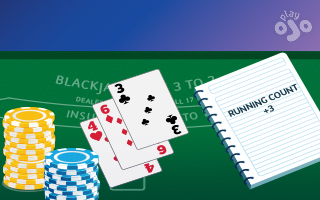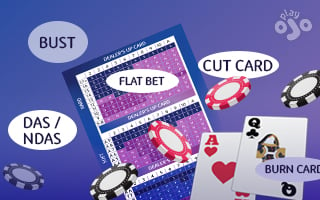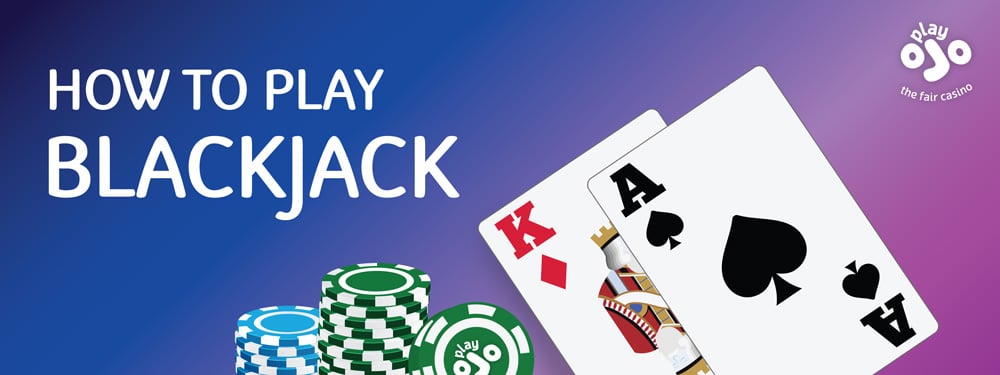
If you want to learn how to play blackjack and be ahead of the game, you’re on the right page, amigo!
Blackjack is one of the easiest casino games to learn and with a little help from OJO, you can become a blackjack pro in minutes. Once you’re an expert, you’ll be ready to play one of the world most exciting card games in casinos or online with virtually no house edge. *double fist pump*
What you’re about to learn
As you make your way down this page, you’ll discover the basics of blackjack including how the game works, what the house edge is and the best strategies for keeping it as low as possible.
Following OJO’s simple steps will save you money and show you how to get the most fun from your playtime.
If you already know your splits, surrenders and soft 17s, you might still learn a thing or two to help you beat the dealer, or just pick up some cheeky trivia to bamboozle your buddies.
Blackjack rules in a nutshell

If you’ve only got 10 seconds to learn how to play blackjack, stop reading this sentence and move on!
Here come the basics…
 Blackjack is a card game involving both luck and skill
Blackjack is a card game involving both luck and skill
In blackjack, you compare your hand to the dealer’s hand. Unlike other casino games, there is a lot of skill involved in blackjack as you face 1 or more decisions during every hand.
 The aim of the game is to make a better hand than the dealer
The aim of the game is to make a better hand than the dealer
One of the biggest misconceptions about blackjack is that you have to try to make 21. Although 21 is the best hand, you only need to beat the dealer to win.
 Blackjack uses 1 or more decks of 52 playing cards, each worth between 1 and 11 points
Blackjack uses 1 or more decks of 52 playing cards, each worth between 1 and 11 points
Blackjack uses a standard deck of cards but gives a points value for each one. Aces are worth either 1 or 11, face cards are worth 10 and all other cards are worth what they say!
 Go over 21 and you bust
Go over 21 and you bust
If when you take a card, your hand total exceeds 21, you bust, or automatically lose, even if the dealer busts too.
 Players are dealt 2 cards and play in turn, with up to 7 players at the table
Players are dealt 2 cards and play in turn, with up to 7 players at the table
Your starting hand features 2 cards. Combine their points values to find out your hand value. Each player at the table plays their hand in turn, starting nearest the shoe to the dealer’s left.
 You can hit, stand, double or split
You can hit, stand, double or split
Depending on the particular set of rules used at your table, you have up to 4 options when it’s your turn to play. You can take more cards, stick with your current hand, split pairs or double down.
 Blackjack is the best possible hand
Blackjack is the best possible hand
If you are dealt an Ace and any other card worth 10, you make Blackjack and cannot lose. If the dealer also makes Blackjack however, you push.
 There’s always a right move in blackjack
There’s always a right move in blackjack
As you see the dealer’s first card before you play your hand, you’ll know roughly what you need to beat, and can play your hand accordingly. You can learn the best move in any situation from a blackjack basic strategy chart.
What you need to play blackjack
Blackjack is played on an instantly recognizable half-moon shaped table.
Although you can play blackjack as a single player game, the table usually features 7 seats or ‘boxes’ around the curved side. The seats are numbered from 1 to 7 starting with the seat to the dealer’s right hand, usually the furthest from the shuffling machine.
The blackjack dealer sits opposite the players and deals the cards from their left to right.
Blackjack is played using a standard deck of 52 cards.
In the early years of the game, it was played with just 1 deck, but after players developed a system called ‘card counting’ to track the cards as they came out, casinos started using 8 decks to remove their advantage.
In land-based casinos and Live Casino online, the cards are shuffled by hand or with an electronic shuffling machine.
In online blackjack, we use a random number generator to recreate the concept of shuffling and produce random cards.
How does a game of blackjack work?
Blackjack is like a play with a number of acts!
In the opening act, you pick a table with an open seat, sit and buy your chips. Once the hand in progress has finished, the dealer will invite you to place your bet.
Once all players at the table have placed their blackjack bet, it’s time for the deal.
The Shuffle
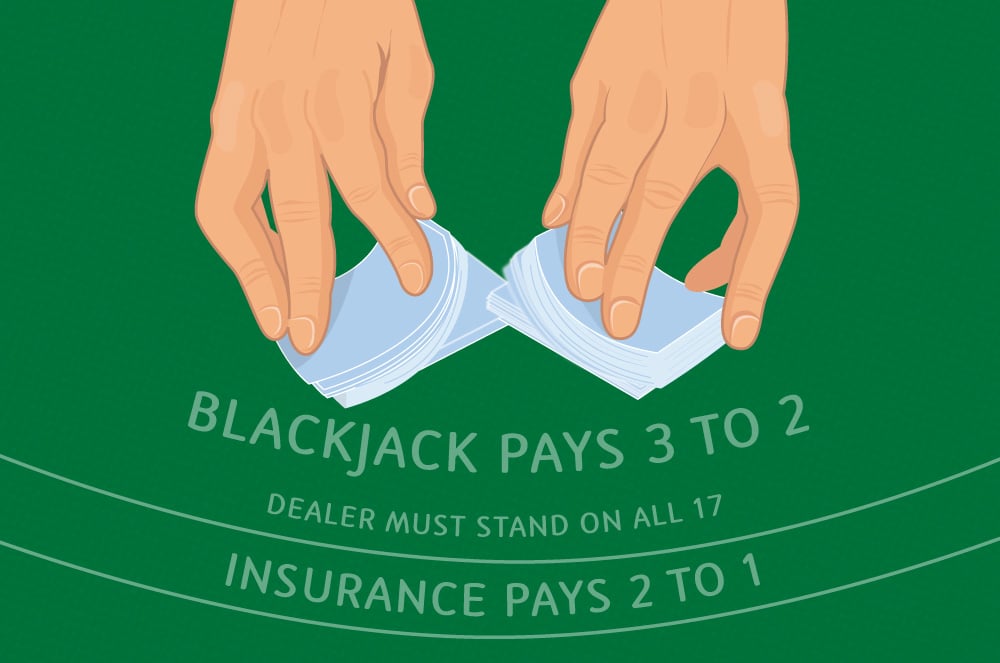
In land-based casinos and in Live Blackjack online, the dealer will often shuffle the cards every time the shoe is almost empty.
They’ll ask a player to cut the deck with a blank colored card to prove that they haven’t manipulated the deck, put the decks back in the shoe and then deal the game until they reach the cut card again.
Some casinos now use a continuous shuffling machine to increase the speed of the game, which means there is no cut and no break in play.
The Deal
The dealer will deal 1 card face up to each player, from the dealer’s left to right, starting with the player in seat 7.
After each player has a card, the dealer gives themselves 1 card face up so everyone can see, then deals the second card, also face up, to each player.
In most types of blackjack, the dealer will stop once every player has 2 cards, leaving themselves with just 1.
Note: In American Blackjack however, the dealer deals themselves a second card face down, and will privately check that card to see if they’ve got Blackjack.
The Action
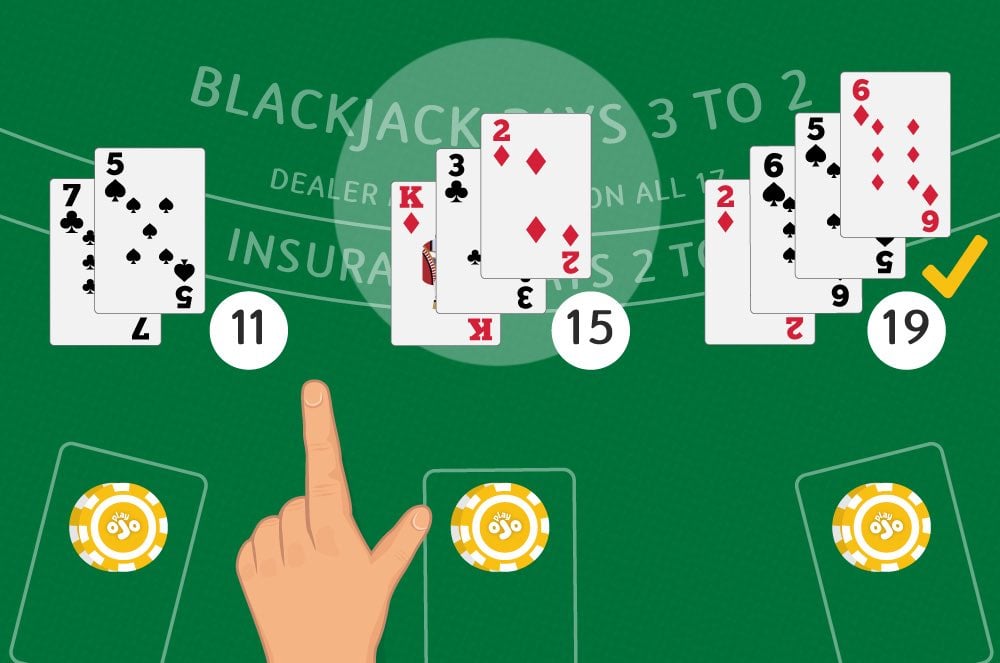
Once everyone has 2 cards, each player takes their turn to play their hand in the order they were dealt. If anyone makes Blackjack, they’re paid out instantly (unless the dealer has the chance to make Blackjack too).
After everyone has either stood or busted, the dealer plays their hand according to the table rules.
You’ll usually see these written across the felt and at most tables, the dealer must continue to hit until they make 17 or more.
In some variations of the game, dealers must stand on hard 17 or more, which means if their starting hand is a soft 17 (Ace and 6), they must hit.
The Payout
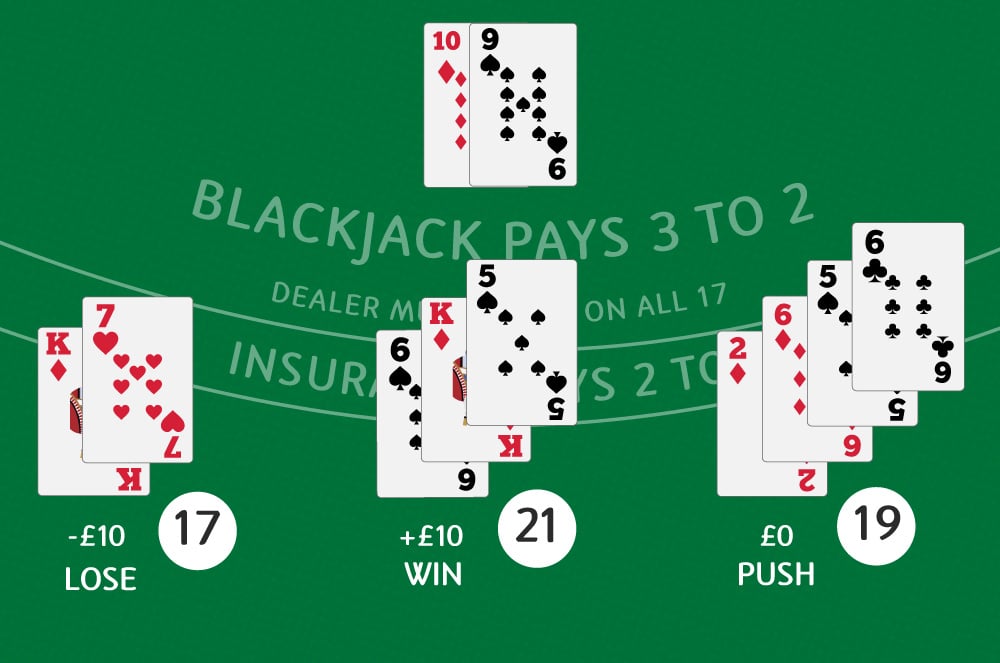
It’s time to settle up! If the blackjack dealer busts, all remaining hands are paid out, regardless of their value. If the dealer makes between 17 and 21, any player hands that are worth more are paid their winnings in the order they were played. Hands worth less will lose, and hands with the same value are a push.
What each card is worth
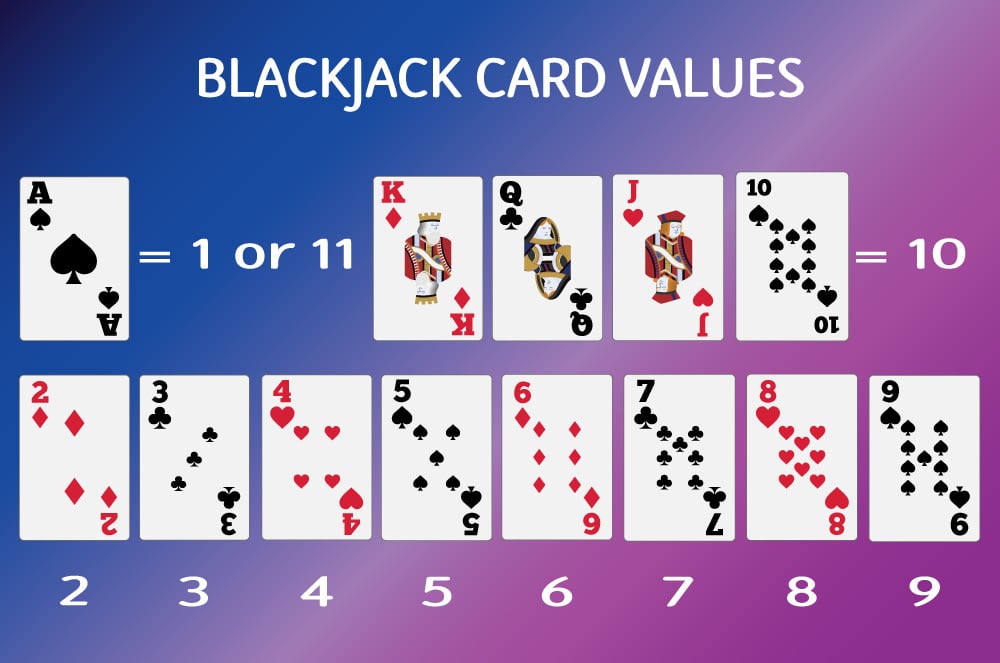
You can’t know how to play perfect blackjack unless you know the most important blackjack rule of all: how to count the value of your hand.
A blackjack deck is made up of 52 cards. All numbered cards from 1 to 10 are worth what they say. Jacks, Queens and Kings are called ‘face cards’ or ‘paint’, and are all worth 10 points. Aces can be worth either 1 or 11 points, whichever is better for your hand.
Card suits – hearts, diamonds, clubs and spades – play no part in blackjack, although they are used in certain types of blackjack side bet.
Knowing what you’ve got
Calculating your hand’s value becomes second nature once you’ve played a few hands, but the dealer will always tell you what you have before your turn.
When you play blackjack online, we’ll always display the value of your hand next to the cards.
Going bust
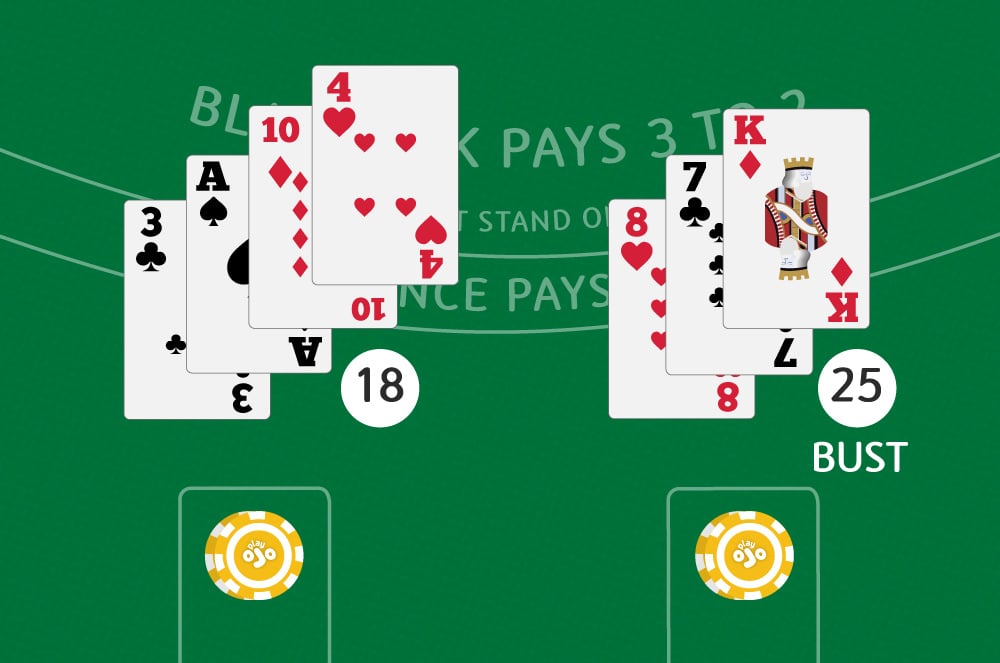
By trying to make 21 or get close, you’ll often make more than 21 and when that happens, the dealer will announce “Bust” and remove your cards and your blackjack bet.
What is Blackjack and why is it different?
When you make 21 with your starting hand, it’s called Blackjack.
You can only hit Blackjack with an Ace (worth 11) and a 10 or face card. Blackjack is a special hand, and not just because it’s the highest score you can make.
Blackjack instantly beats any dealer hand except Blackjack. You won’t have to wait for the round to finish before you get paid out either, as the dealer will pay you out as soon as all hole cards have been dealt.
Soft and hard hands
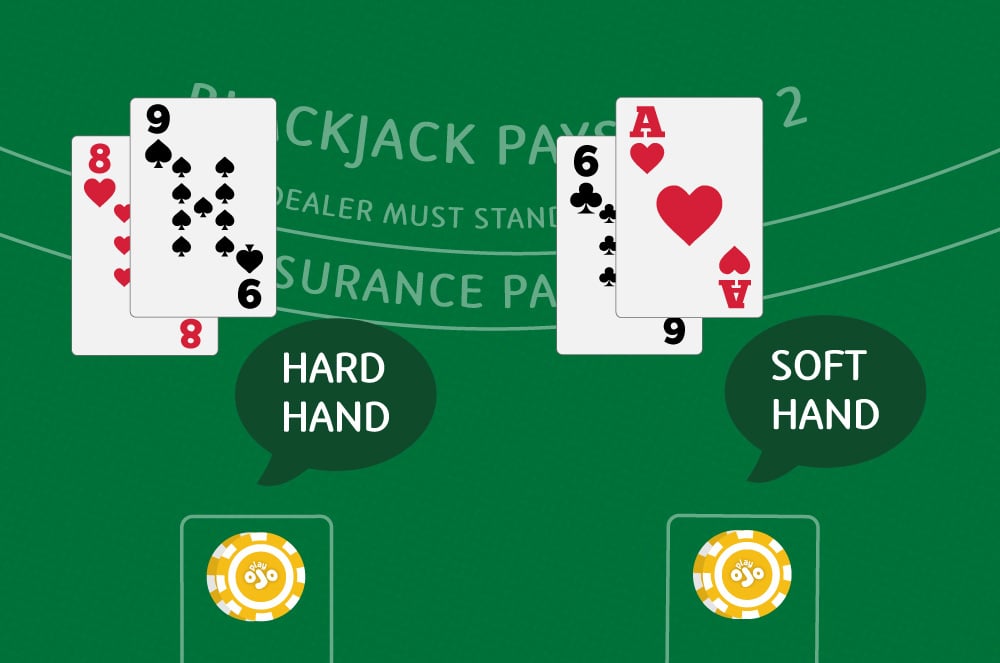
Because Aces can be worth both 1 and 11, there are 2 types of hand – hard and soft. Hard hands are those which either don’t include an Ace, or if they do, the Ace cannot be counted as both 1 and 11.
Soft hands include an Ace which counts as 1, and they get their name because they can’t bust on the next card.
The blackjack rule about soft and hard hands only usually matters in 2 situations.
The rules the dealer has to follow when they play their hand, and the Basic Strategy chart you can use to make the best decision.
How do blackjack hands end?
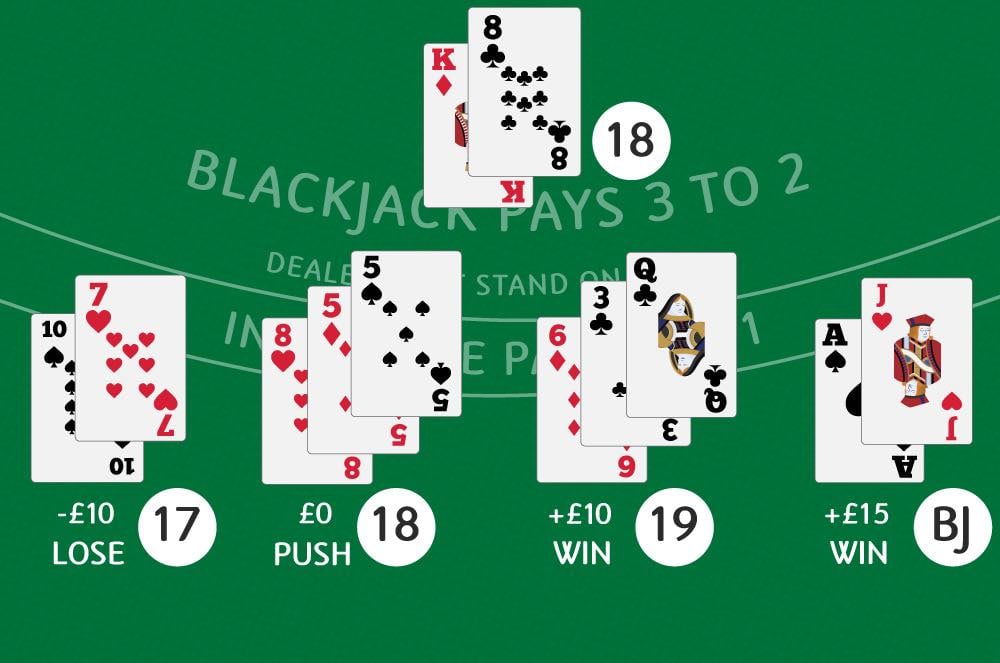
There are 3 possible outcomes in a blackjack hand as well as some exceptions to these rules when you or the dealer gets Blackjack itself.
Win: There are 2 ways to win a hand of blackjack ; If your hand is better than the dealer, or if dealer busts.
Lose: If you bust, or if the dealer’s hand is better than yours, you lose.
Push: If the dealer makes the same hand as yours, it’s a draw and you get your stake back.
Blackjack is a double-or-nothing game where winning hands are paid out at ‘evens’ or 1 to 1. If you bet £10 and win, you’ll get £20 back and make a £10 profit.
The payout for making Blackjack is 3 to 2, which means you win an extra 50%. If you bet £10 and make Blackjack, this time you’ll win £25 back for a £15 profit.
How to place your bets
When the blackjack betting round opens, you’ll have a short amount of time to place your bets before the dealer announces “No more bets”.
Every blackjack table has a minimum and maximum bet and it’s always useful to know the limits before you pick which table to play.
If you’re playing in a real casino or playing Live Blackjack online, pick an empty seat and think about what bet size you want to play.
If you’re playing a traditional computer blackjack game, the table’s all yours and you’ll have between 1 and 3 boxes to choose.
Choosing how much to bet
In gambling, picking the right bet size is part of something called bankroll management.
Choosing how much to bet is as important in blackjack (and any casino game) as what to do with your hand.
Choosing a bet size and betting strategy which fits your bankroll can help you weather the natural ‘win some, lose some’ pattern of blackjack results.
It will also help you follow the correct strategy when the correct strategy is to put more chips in the middle.
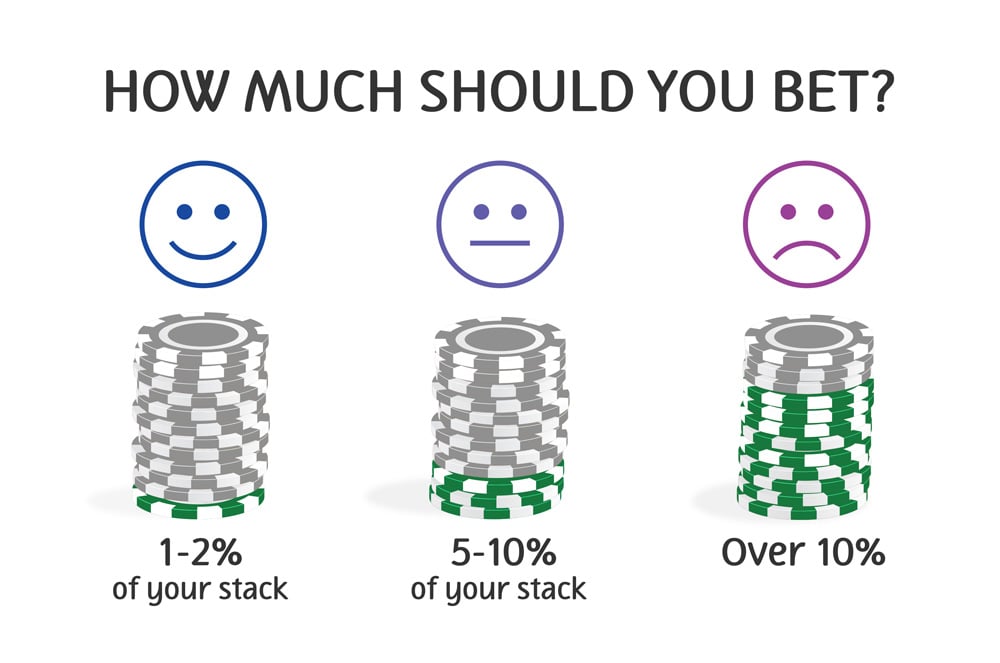
Aside from basic Safer Gambling rules such as only betting what you can afford to lose, there are various factors to think about when picking your bet size.
- How many hands you’re playing simultaneously
- If you’re making side bets
- How long you intend to play
- If you will vary your bet size or keep it the same
What each chip is worth
Once you’ve picked you stake, you’ll need to place the bet using real or virtual casino chips.
Blackjack players usually bet in nice round amounts, whether it’s £1, £10 or £500, and the casino chips are there to make it easier to bet. Even if you want to bet £9, it only takes a few chips or clicks.
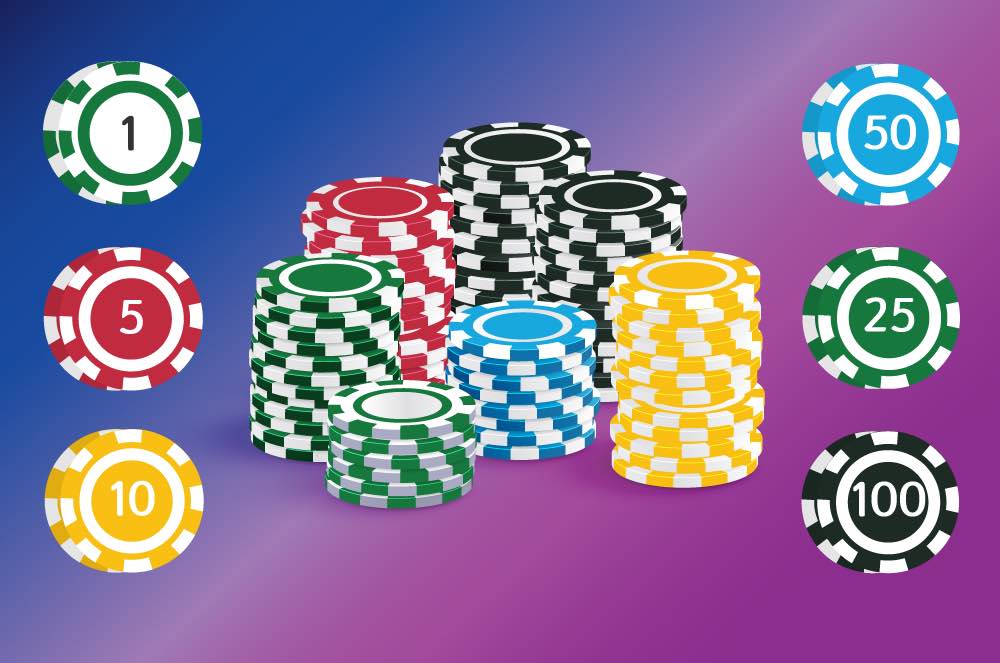
Blackjack chips usually come in a variety of denominations from 50p to £1, £5, £10, £25, £50, £100 and £500.
Chips are usually recognized by their color and the amount printed on both sides. Colors can vary from casino to casino and online game supplier, but usually you will find that 100 chips are black, 25 is green, 5 is red and 1 is white.
Playing multiple hands
In traditional online blackjack games, you’ll be the only player at the table, and you can often play up to 3 boxes at the same time.
In real casinos and Live blackjack tables online, you can play up to 7 boxes, provided no other players are using them.
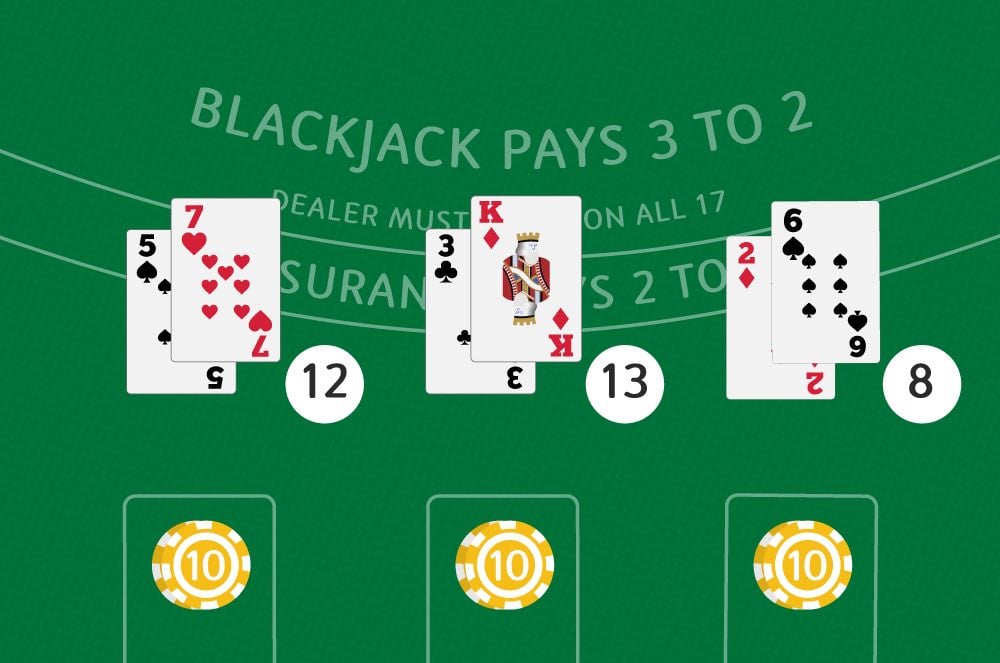
When playing more than 1 hand, you’ll play each hand in turn, starting with the hand to your right.
As long as you divide the amount you would normally bet on 1 hand by the number of hands you want to play, you effectively spread your risk and even out the variance.
Although you might occasionally lose all 3 hands when the dealer gets Blackjack (or win all 3 hands when the dealer busts), more often than not you will make a net win or loss of 1 unit.
Betting behind
If there’s no room at the table, or if you feel like someone else is on a hot streak, you can bet on another player’s hand. This is called betting behind, because you literally place your chips behind theirs.
It’s still down to the player who’s seated to make the decisions, so you have to hope they know their strategy (or they’re lucky!).
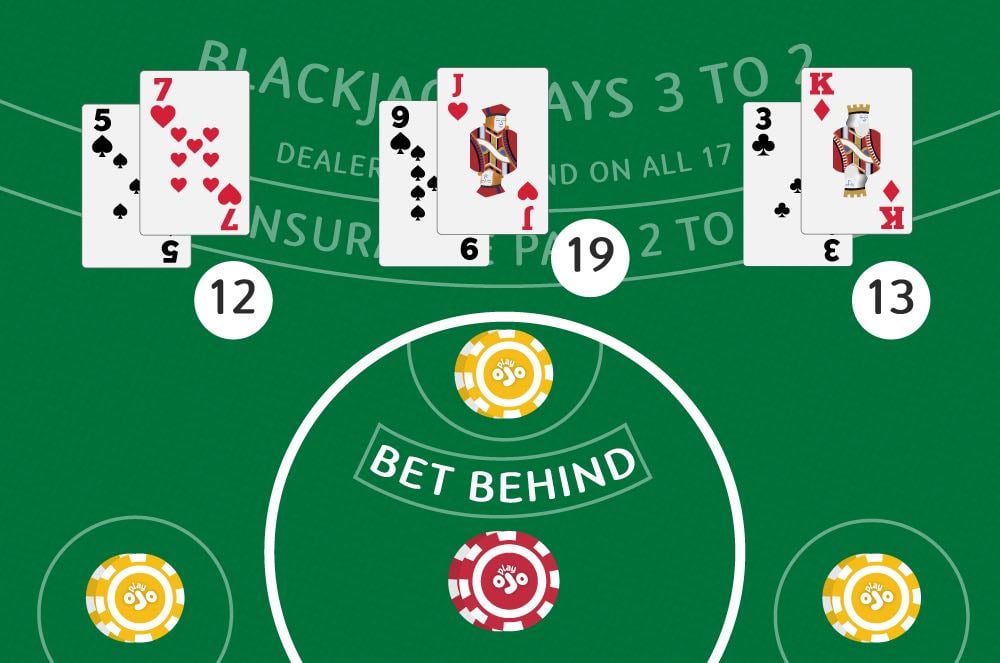
Bet Behind isn’t just for players who are seated at the table, as anyone watching the table can join the action too, even people who don’t know how to play blackjack. The stakes for betting behind are often lower too. Normally when you bet behind online, you’ll copy the player’s decisions, including doubling and splitting, though you can change the game setting if you want to make some of those decisions yourself.
How to play your hand
Now it’s time for the skill to come into play. Depending on the cards you’ve been dealt, you’ll have a few options; Stand, hit, split or double.
The moves you make have a big impact on the house edge, especially when it comes to hitting and standing.
You can take as many actions as you like until you make 21 (at which point your turn will automatically end) or until you bust.
In some variations of the game played outside casinos, you get extra credit for a hand with 5 cards or more, but not in blackjack.
The only thing that matters is your score.
| Action | Description | Signal |
| Hit | Take another card to increase your score. | Tap the table, nod head |
| Stand | Happy with your hand? Take no more actions and end your turn. | Wave hand horizontally palm down, shake head |
| Double | Double your stake and receive only 1 more card | Place a second bet alongside the first |
| Split | Split any pair for the cost of one more bet. If you split Aces you only get 1 more card, and you cannot make Blackjack | Place a second bet alongside the first |
| Surrender | Forfeit your starting hand and lose half of your bet | Say it out loud, make V with fingers |
| Insurance | When the dealer has an Ace, bet half your stake and get paid 2 to 1 if the dealer makes blackjack. | Say yes when the dealer asks |
Blackjack strategy for beginners
When a player asks us ‘How do you play blackjack?’, the short and long answer is to follow the universally accepted basic blackjack strategy. To play perfect blackjack, you need to learn how to use basic strategy charts and commit them to memory.
But for beginners starting out on their blackjack adventure, we can sum up basic blackjack strategy in 5 rules of thumb. Follow this simplified blackjack strategy advice and you won’t go far wrong!
- Stand on 17 or more
- Stand on 12 to 16 vs 6 or less
- Hit 16 or less vs 7 or more
- Double 11 vs all but Ace
- Double 10 vs 9 or less
- Split 88 and AA
How different blackjack rules change the game
Blackjack games around the world use different rules and although you might not feel the effects of the more obscure blackjack rules very often, they each make a difference to the most important factor of all, the house edge.
How many decks are used
If you can find a single deck game, go for it! The more decks you play with, the higher the house edge with 8 decks worth an extra 0.6% house edge over 1 deck.
 How the dealer plays Soft 17
How the dealer plays Soft 17
The most obvious example is what the dealer has to do on a soft 17. In some games, they continue to hit until they make a hard 17 or more. If a dealer has to hit on soft 17, it improves their chances of making a better hand and adds 0.22% to the house edge. In all games at PlayOJO, the dealer has to stand on soft 17.
How much you win with Blackjack
You might come across some tables that only pay 6 to 5, instead of 3 to 2. These numbers might be Greek to most of us, but the result of this rule is clear. In 6 to 5 blackjack, you make a profit of £12 compared to £15 in our 3 to 2 version. That’s a massive 1.3% extra house edge and worth avoiding unless it comes with some of the other beneficial rules below.
When you can double down
In some games you’re restricted to doubling down on 9, 10 or 11 only, whereas in other games you can double on any score. This is obviously the best version for players and it’s worth almost 0.1% in house edge.
How many times you can split and resplit
Splitting cards is one of the least important blackjack rules when it come to the impact on house edge, but you may notice a difference in how many times you can split (from once to a maximum of 3 times), and whether you’re allowed to double down on split hands.
 If you can surrender
If you can surrender
This rule isn’t found much outside the US. But when it is used correctly, the option to surrender your hand can reduce the house edge by up to 0.7%. Every little counts!
Although we’ve explained the various rules in isolation, you’ll find that most blackjack tables use a combination of these rules to balance out the edge.
In European blackjack at PlayOJO, you play with 8 decks, can split up to 3 times and double on 9 or above. Together with other rules, that creates a house edge of 0.61%.
In American blackjack, you can double on any starting hand and the dealer will check if they have blackjack, so the house edge is cut to just 0.43%.
What is the house edge and how can you reduce it?
With a house edge of less than 1%, blackjack is one of the most attractive online casino games for players. A stellar Return To Player of over 99% means players who play ‘correct’ blackjack can continue playing for hours with the same starting bankroll.
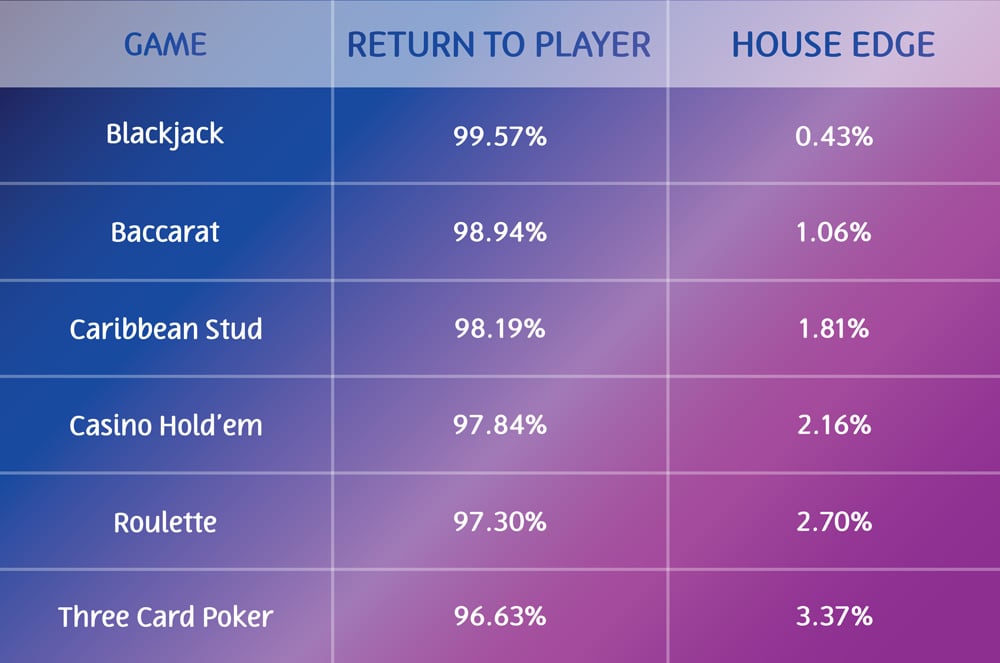
Skill level and game rules: The keys to keeping the house edge down
There are 2 ways to ensure you get the best possible deal when you play blackjack; First, find a game with the highest payout percentage. By shopping around, you should be able find blackjack tables with a house edge below 0.50%.
Once you’ve found a game you like, you need to ensure you get the right payout percentage by playing as skillfully as possible. As the blackjack house edge depends on the quality of the decisions you make in each hand, it varies from player to player.
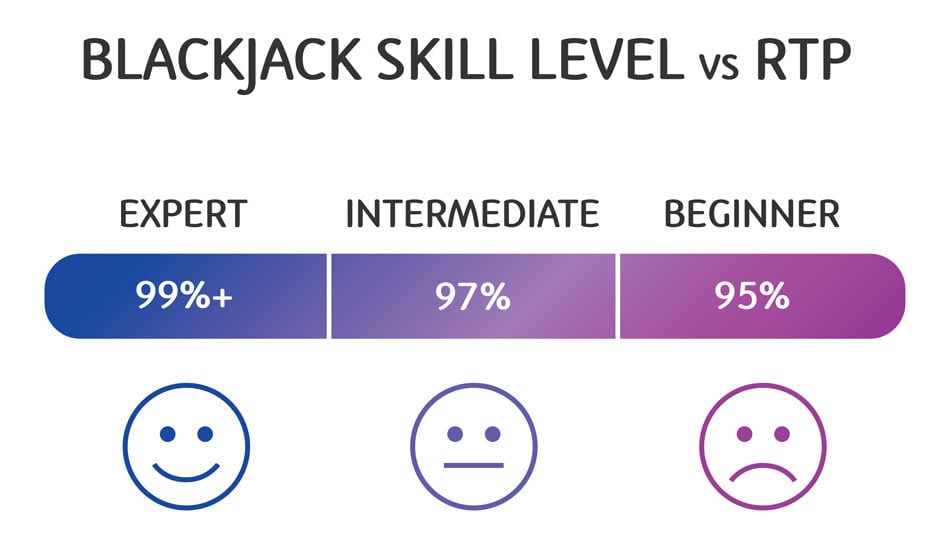
In a blackjack game with a 99.50% RTP, expert players can expect to get a payout of very close to 99.50% by following basic strategy to the letter.
The least skilled (or most reckless!) players might only get a 95% RTP, while the average blackjack player probably sees a return of somewhere between 97-98%.
It’s clear that casinos make more money from players who don’t know how to play.
So if you want the best blackjack RTP, you have to pick the right tables and learn how to play blackjack properly.
What is blackjack etiquette?
If you’ve never played blackjack in a casino, knowing how to behave and what not to do will help make your first time more comfortable.
These tips are mostly for playing blackjack in real casinos, but it’s worth knowing the do’s and don’ts of how to play blackjack and many will still come in handy when you play Live Blackjack online.
Do….
- Tell the dealer your decision using your hands. Watch other players and learn the hand signals.
- Ask the dealer if you want advice on the best move or how to play.
- Be polite and take wins and losses just the same. You’ll see plenty of both in a session, so be prepared.
- Thank the dealer at the end of their shift. It’s good manners and good karma!
Don’t…
- Tell other players how to play or criticise them for playing a different way.
- Touch your cards, ever. Only touch your chips when you place bets or collect winnings.
- Try to hand money to the dealer, they won’t take it! Place it on the felt.
- Be messy. Stack your chips neatly and keep your drink off the felt.
What are blackjack side bets?
Once you’ve experienced the thrills of online blackjack, what if you want even more action at the table? Side bets are additional games you can play at the table that are usually based on what cards you’re dealt.
They’re pure luck and they offer much bigger odds than the double-or-nothing you get in blackjack.
You’ll see the side bet areas clearly marked on the felt, and you place your bets at the same time as your blackjack hand bets.
Perfect Pair: Win up to 30 to 1 when you make mixed, colored or perfect pairs.
21+3: A 3 card poker style game using your 2 cards and the dealer’s up card which pays out for flushes, straights, straight flushes and 3 of a kind.
Blackjack versus roulette
Although OJO loves both games, there are some big differences in how the 2 most popular casino games work.
Firstly, blackjack has a lower house edge. While most roulette games have an edge of 3%, blackjack games can be as low as 0.2%.
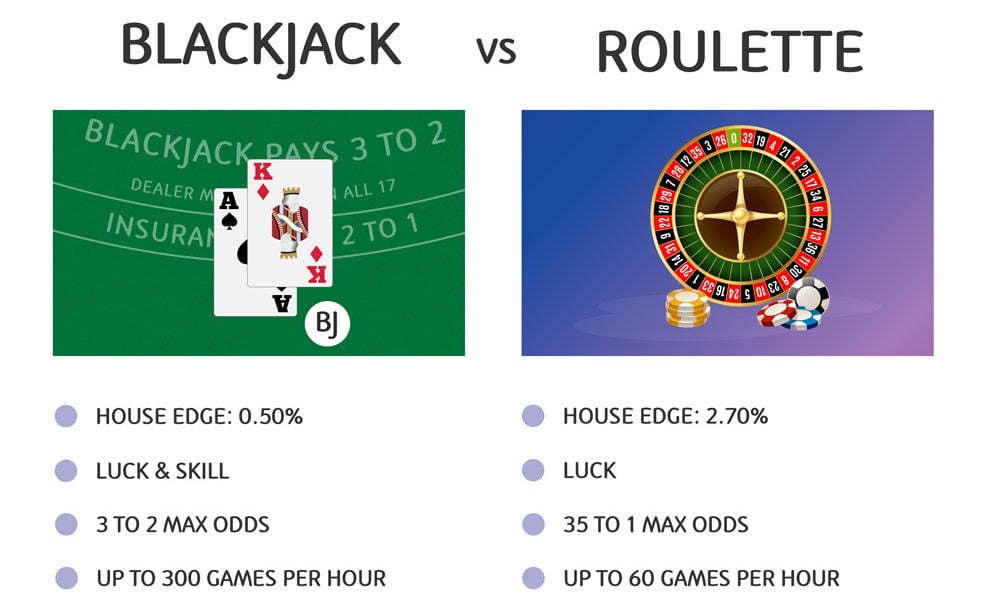
Roulette is a game of pure chance whereas blackjack is a combination of luck and skill, so you get a big say in the outcome of games.
Blackjack is more social too. When you play roulette online, it’s either a single player game or everyone places their blackjack bets at once.
In blackjack, you can be sat next to 6 other players and many more playing behind. And that brings us to OJO’s favourite benefit of blackjack over roulette – you get to sit down!
Play blackjack in a real casino and you’ll be sat down, and you may even get a drink and some food too.
The history of blackjack
No one really knows where blackjack came from, but the first mentions of a card game called ‘Twenty One’ appeared in literature from France and Spain in the 1600s.
Although blackjack is the most widely played version today, similar versions called Pontoon and Vingt-et-Un can still be found across the world.
Twenty One exploded in popularity in America during the 1900s in the riverboat gambling era. The 21 card game was renamed blackjack once it reached Las Vegas and it made the news in the 1950s when a group of gamblers and mathematicians discovered a way to beat the game.
By the 1960s, Thorpe’s famous book Beat The Dealer had become a global hit. Thorp revolutionised how to play blackjack by revealing the secret to gaining an edge through counting cards.
Soon afterwards, every casino in the world adapted its rules to protect themselves from the armies of amateur counters.

When the internet went mainstream in the 2000s, blackjack took another leap forward, becoming the perfect test case for online gambling.
Early versions were pretty crude but it didn’t take long for the companies like Evolution Gaming to replicate the feel of a casino with the Live Blackjack games you can play at PlayOJO today.
What’s next? The technology for virtual Reality and augmented reality games is already here, but whether players want their blackjack this way, we don’t know.
Will we be stood in our living rooms, waving our hands at the holo-dealer like Tom Cruise in Minority Report? Only time will tell…
Once thing’s for sure, blackjack has a way of adapting so it remains the king of the casino jungle! Now you’re an expert, it’s time to play!
What you’ve learned in this guide
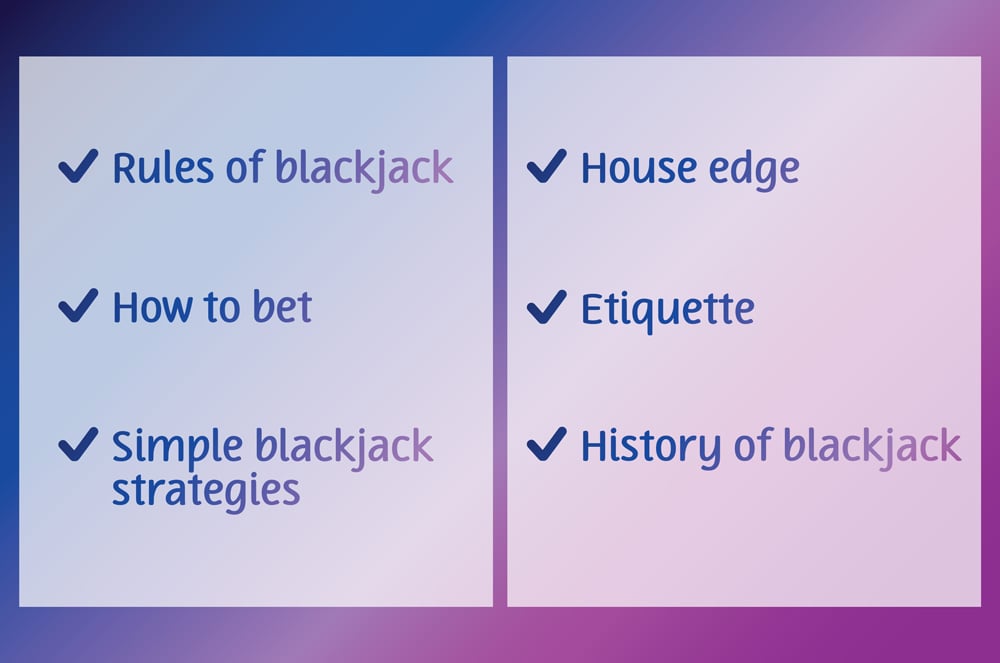
By now, you should be a jack of all trades (don’t worry, you’ll soon be a master of them too) when it comes to knowing basic blackjack rules, how to bet and the simple strategies that’ll help keep the house edge as small as possible.
As well as knowing how the game works and how to avoid common pitfalls that cost other players money, you also know the secrets of blackjack etiquette that took everyone else days to figure out.
Looks like you’re ready for the step up to the big leagues. Good luck!


 Blackjack is a card game involving both luck and skill
Blackjack is a card game involving both luck and skill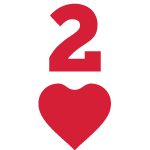 The aim of the game is to make a better hand than the dealer
The aim of the game is to make a better hand than the dealer Blackjack uses 1 or more decks of 52 playing cards, each worth between 1 and 11 points
Blackjack uses 1 or more decks of 52 playing cards, each worth between 1 and 11 points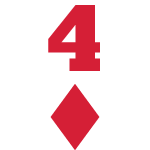 Go over 21 and you bust
Go over 21 and you bust Players are dealt 2 cards and play in turn, with up to 7 players at the table
Players are dealt 2 cards and play in turn, with up to 7 players at the table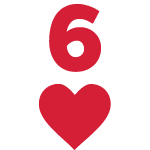 You can hit, stand, double or split
You can hit, stand, double or split Blackjack is the best possible hand
Blackjack is the best possible hand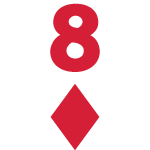 There’s always a right move in blackjack
There’s always a right move in blackjack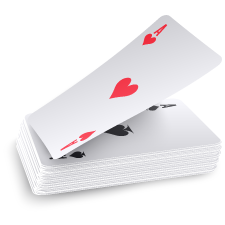
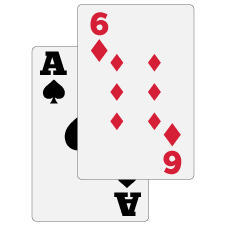 How the dealer plays Soft 17
How the dealer plays Soft 17
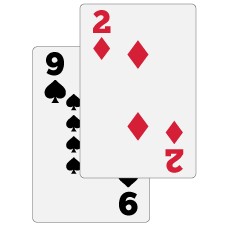
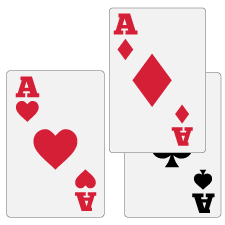
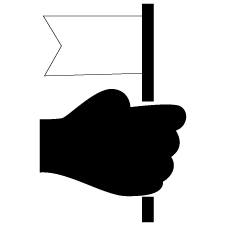 If you can s
If you can s


